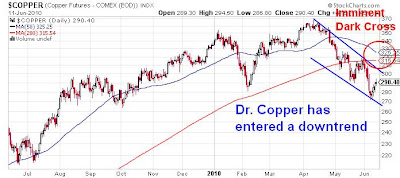I have become
increasingly concerned about the markets and the economy, largely because of the poor behavior of economically sensitive commodity prices. If the current commodity weakness were to persist, then conditions may be setting up for a repeat of the Great Bear of 2008.
Commodities are signaling trouble
As an example, the price of Dr. Copper, which earned its nickname of having a Ph.D. because of its ability to forecast downturns, is in a downtrend and on the verge of a dark cross.
The Reuter/Jeffries CRB Index has already exhibited a dark cross.
Ominous readings from the Inflation-Deflation Timer model
My
Inflation-Deflation Timer model, which is a trend following model based on the price movement of commodity prices, is on course to flash a “deflation” signal the week of June 21 unless commodity prices stage a strong and broad based rally from current levels.
My concern stems from the quick transition from an “inflation” signal to a potential “deflation” signal. The model only moved from an “inflation” reading to “neutral” in
early May. For the model to go from an “inflation” to “deflation” reading in six weeks is highly reminiscent of the Lehman crisis experience of 2008.
The chart below shows the model signals for the critical period from December 2007 to December 2009. The black line shows the cumulative simulated returns of the Inflation-Deflation Timer model, where the red line shows the cumulative returns of equities, the purple line commodities and the green line the US long Treasury Bond. The pink shaded area indicate periods when the Inflation-Deflation Timer showed an “inflation” signal, the white areas a “neutral” signal and the light blue areas a “deflation” signal.
Anatomy of a Financial Crisis
In 2008, the model moved turned “neutral” from an “inflation” reading in late June and went to a “deflation” reading in early August, in the space of about five weeks. Financial markets were already tanking during the July transition period when the model reading was “neutral”. As the model went to “deflation” signal, the markets panicked and went into freefall because of the Lehman crisis and virtual all asset classes got clobbered.
While in 2008 the Inflation-Deflation Timer correctly moved to the safety of US Treasuries during the Lehman crisis and then rotated back into risky asset classes as the crisis ebbed, I remain concerned about the current backdrop of market psychology and macro-economic landscape. Today, we have a similar situation where model readings are potentially transitioning quickly from an “inflation” to “deflation” reading, which is highly unusual, and financial markets are jittery and under stress.
Is this just a correction or something worse?
To be sure, we may not see a 2008-like waterfall decline because markets are oversold and may have begun a reflex rally. Investor sentiment remains bearish, which is contrarian bullish. The blog post at
Trader’s Narrative put the sentiment picture into context. Current readings are consistent with a market bottom if this is a run of the mill correction, but not extreme enough for a bottom if the recent action represents the re-emergence of a bear run.
What if this is the re-emergence of a bear market? There is good support for such a thesis.
George Soros recently warned that we are now in Act II of the global economic crisis.
John Hussman also warned about “Aunt Minnie” type conditions in his market comment dated May 24, 2010 [emphasis added]:
Such indicator subsets, or Aunt Minnies, are essentially "signatures" that often have very specific implications. In medicine, an Aunt Minnie is a particular set of symptoms that is “pathognomonic” (distinctly characteristic) of a specific disease, even if each of the individual symptoms might be fairly common. Last week, we observed an Aunt Minnie featuring a collapse in market internals that has historically been associated with sharply negative market implications…
Historically, we can identify 19 instances in the past 50 years where the weekly data featured broadly negative internals, coupled with at least 3-to-1 negative breadth, and a leadership reversal. On average, the S&P 500 lost another 7% within the next 12 weeks (based on weekly closing data), widening to an average loss of nearly 20% within the next 12 months - often substantially more when the Aunt Minnie occurred with rich valuations and elevated bullish sentiment.
Even
Paul Volcker, the former central banker who is so circumspect that he once quipped that when he went out for dinner, he would say that “I’ll have the steak, but that doesn’t mean I don’t like the lobster”, has become vocal about his own pessimism: “I don’t remember any time, maybe even in the Great Depression, when things went down quite so fast, quite so uniformly around the world.”
In addition, ECRI confirmed Volcker's view of economic weakness as its
weekly leading indicator (WLI) turned negative last Friday. However, Lakshman Achuthan of ECRI qualified the negative reading and indicated that the negative reading is not a forecast of recession but a forecast of slower growth.
Don't panic yet
What should investors do in the face of this negative and high risk backdrop?
From my own viewpoint, I am maintaining the discipline of adherence to the Inflation-Deflation Timer model and I am not in the business of anticipating signals. At this point, I would not batten down the hatches or run for the hills - yet. However, these conditions are creating a high degree of concern about the near-term downside potential of returns for many asset classes.
However, the possibility of such a negative signal makes me ever cautious. Commodity markets need to stage a significant rally this week to negate the potential negative signal next week.
It’s not time to run into the bomb shelter, but it wouldn’t hurt to crack open its door.















